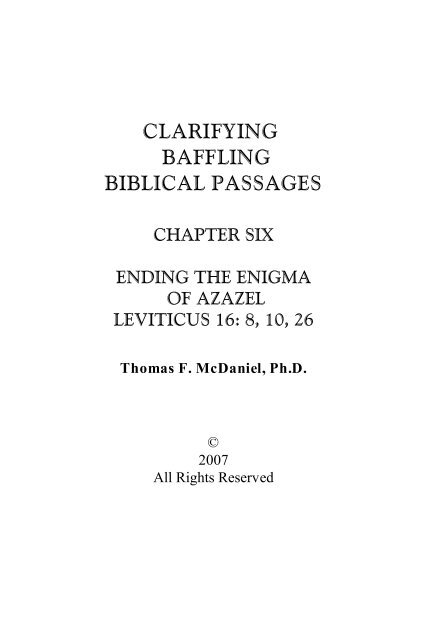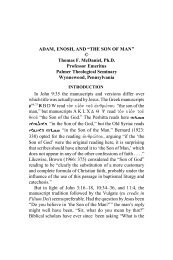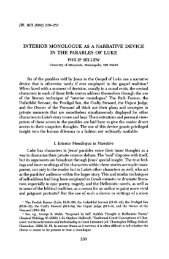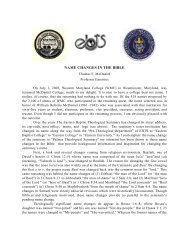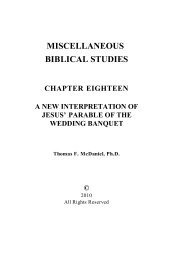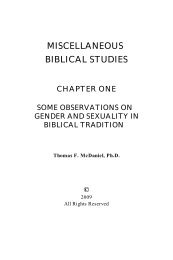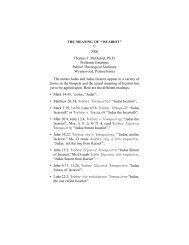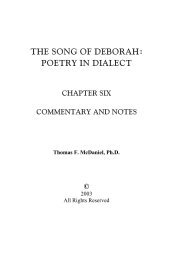CLARIFYING BAFFLING BIBLICAL PASSAGES - E-Net Services
CLARIFYING BAFFLING BIBLICAL PASSAGES - E-Net Services
CLARIFYING BAFFLING BIBLICAL PASSAGES - E-Net Services
Create successful ePaper yourself
Turn your PDF publications into a flip-book with our unique Google optimized e-Paper software.
<strong>CLARIFYING</strong><strong>BAFFLING</strong><strong>BIBLICAL</strong> <strong>PASSAGES</strong>CHAPTER SIXENDING THE ENIGMAOF AZAZELLEVITICUS 16: 8, 10, 26Thomas F. McDaniel, Ph.D.©2007All Rights Reserved
VIENDING THE ENIGMA OF AZAZELLEVITICUS 16: 8, 10, 26INTRODUCTIONNoth (1965: 125) conceded that “the figure of Azazel [inLeviticus 16] remains an enigma,” and Levine (1989: 102)concurred stating, “The precise meaning of Hebrew c aza c zel,found nowhere else in the Bible, has been disputed sinceantiquity and remains uncertain even to the present time.”However, appeal to several Arabic cognates heretofore ignoredwhen attempting to interpret Lev 16:8–26, may resolvemany of the difficult problems related to the etymology ofAzazel.In the Septuagint Azazel was not read as a name but as acommon noun translated avpopompai,w| (16:8), avpopompai,ou(16:10), and avpopomph,n (16:10), meaning “sending away,carrying away” (Liddell and Scott 213). 1 Similarly, in 16:26,Azazel was read as a compound of lz[ “to separate” and lza“to go away” and rendered to.n ci,maron to.n diestalme,noneivj a;fesin “the goat separated for release.” Nor did the Vulgateread Azazel as a name but as z[e “goat” and lza “departing,”which became capro emissario (16:8) and caprum emissarium(16:10) “a goat [that] departs.”The Targum Pseudo-Jonathan (Clark 1984: 138) tookAzazel to be the place name of the scapegoat’s destination:~qwty lzaz[l 2 abd[ ywl[ qylsd arypcwtyb am[ twnxrws l[ arpkl yyy ~dq !yyxb@yqt rtab tmmyl hyty ardXl larXy
48 ENDING THE ENIGMA OF AZAZEL4 yrwdh tyb awhd qwcd arbdmbd yXqw(Lev 16:10)ayyrwwj l[ arypc qwsyw qwcd arbdmlaqyz xwr hynyxdyw 4 yrwdh tybd3twmyw yyy ~dq !m(Lev 16:22)And the goat on which came up the lot for Azazel he shallmake to stand | alive before the Lord, to expiate for the sinsof the people of the house | of Israel, by sending him to diein a place rough | and hard in the rocky desert which is Bethhadurey(Lev 16:10). . . . to a rocky desert; and the goat willgo up on the mountains of | Beth-hadurey, and a tempestuouswind from the presence of the Lord will carry himaway and he will die (Lev 16:22). 4The Beth-hadurey / arwdh tyb “the place of a steep hill,spiral road” (Jastrow 1903: 332–333) is a place name analogousto the !rh tyb (= Tel er-Râm) in Num 32:36, with thearwdh being the singular of the ~yrwdh “hills, swellingplaces, land swells” mentioned in Isa 45:2, which the Septuaginttranslated simply as o;rh/ “mountains,” whereas the KJVopted for “crooked places.” 5 It would be a synonym of qAc“peak, precipice” (Jastrow 1270). The arwdh tyb need notmean a particular precipice, but any precipice, just as lzaz[was considered to be any hard, rough, rocky, desert mountainor height.References to Azazel in the Talmud (Yoma 67 b ) and Midrash(Sifra, Aḥare 2:8.) treated it as a compound noun ratherthan as a name. Two phrases are quite clear: ahyX lzaz[hXqw z[ and ~yrhbX hXq lzaz[ which were translatedby (1) Jung (1938: 316) as “Azazel–it should be hard and
LEVITICUS 16:8, 10, 2649rough” and “Azazel, i.e., the hardest of mountains” and (2) byGoldschmidt (1933: 946–947) as “Âzazel, er muss fest undhart sein” and “Âzazel ist der höchste unter den Bergen.”Goldschmift and Jung read the z[ of lzaz[ as z[; “strong,firm, rough,” clarified by its synonym hXq “hard, severe,strong” (Jastrow 1060, 1429), which required them to dismissthe lza element of lzaz[.CLUES FROM ARABIC COGNATESThe Arabic cognates rBé ( c azala) and Ax\ ( c anz), not mentionedin other studies of Azazel, permit the following translationof the phrases from Yoma 67 b : (1) hXqw z[ ahyX lzaz[,“Azazel which must be a rugged height and harsh” and (2)~yrhbX hXq lzaz[, “Azazel is any harsh place which isin the mountains.” These two cognates permit the interpreterto account for Azazel being described in the MT, the Targumand the Talmud as rbdm “wilderness,” arwdh “rugged land,hill, precipice,” and hr"zEG> “precipice,” along with the modifiershXq and @yqt “hard, harsh, rough, and rocky.”Castell (1669: 73) included in his citation of Hebrew/Aramaic lza these Arabic cognates: rBé ( c azala) “in angustiastatûs, vel anni inopia verstatus fuit”; rBé ( c azil) “angustiasumma, penuria & sterilitas”; and rB"s (ma c zil) “locus arctus& angustus.” Lane (1863: 53–54) cited rBé ( c azala) “hebecame in the state of straitness, or narrowness, and sufferingfrom dearth, or drought or sterility,” and the nouns (1) rBé( c azl) “straitness, distress, difficulty, drought, or want of rain,”(2) rBé ( c izl) “a calamity,” (3) rBé ( c azil) “straitness, severe,or vehement stress, distress, or great difficulty,” and (4) rBès(mâ c zil) “the place where the means of subsistence are strait,
52 ENDING THE ENIGMA OF AZAZELcame identified with the name of Azazel (= “God is fierce”),resulting in the demotion of Mot from being a deity to beingjust a demon which became known as Azazel.In the intertestamental literature Azazel was recognized asone of the “sons of God” who, according to Genesis 6 andEnoch 6, abandoned their heavenly habitation for the theircohabitation with earthly women. 12Milgrom (1991: 44, 1020–1024) argued for Azazel beingthe name of an “eviscerated” demon who lost his personalityand became transformed simply into the name of the place towhich the scapegoat carried Israel’s sins and impurities—similar to Wright’s conclusion (1992) that the demon’s namewas “a place-holder representing the geographical goal of thescapegoat’s dispatch.” Levine (1991: 102), by contrast, preferredto promote Azazel to the rank of a demonic ruler of thewilderness, much like the ~yrIy[if. “goat-demons, satyrs”mentioned in Lev 17:7.The claim by Levine (1989: 102) and Milgrom (1991:1020) that the initial l of lzaz[l is the lamed auctoris,rather than the equivalent of the locative h of the followingmodifier hr'B'd>Mih;, would have one goat “belonging to Azazeland one “belonging to the Yahweh,” supposedly providinga kind of parity of possession by two unequal supernaturalbeings. But both goats were “earmarked” for Yahweh andboth were marked for death. One was to die upon the altar asa sin offering to Yahweh (taJ'x; Whf'['w> hw"hyl;); the otherwas to make atonement before Yahweh (rPek;l. hw"hy> ynEp.liwyl'[') 13 as a scapegoat to be dispatched in due time to thewilderness where it would die of straits and distress or perish—falling or thrown—from a precipice, thereby taking all thesins of Israel into oblivion. 14
LEVITICUS 16:8, 10, 2653SUMMARY AND CONCLUSIONContrary to the opinion of a number of commentators pastand present 15 that the Azazel in Leviticus 16 refers to a demonto which a scapegoat was dispatched, there is sound philologicalevidence for interpreting it—as in the Targum andTalmud—as a topographical term having nothing to do withdemons. Hebrew lzaz[ can be recognized as a compound ofz[ “rugged peak” and lza “difficult, distressful, dearth,” withthe lza being the modifer of the z[. At one time, as suggestedby the translations in the Septuagint and Vulgate, the text maywell have been lza z[l, with a space between the noun andits modifier. 16 Once the space disappeared in the textual tradition,the topographical designation lzaz[ became easily confusedwith names like laez"[] (Aza c el), lyzEz"[] (Azazêl), andlazz[ (Azaz c el) (4Q 180; 11QTemple 26:13), which triggeredan easy association with the names of the rebellious angelslisted in Enoch 6, which, in turn, made it easy to identify theAzazel with the world of demons and demoted deities.The enigma of Azazel in Leviticus 16 can thus be resolvedby philology rather than by demonology. A careful examinationof Arabic cognates can help in the recovery of meaningsof words which have yet to be included in the standard lexiconsof Biblical Hebrew—words which were clearly understoodby the contributors to the Targum and the Talmud,though unknown to most of the interpreters of these texts. Inthe case of the Azazel tradition in Leviticus 16 (both the MTand the Vorlage of the Septuagint), the following Hebrewterms need to be added to the lexicon:
54 ENDING THE ENIGMA OF AZAZELlza “straits, distress, hard, harsh, severe, calamity”dwd “to remove, to repell (from sacred territory)”lz “slippery ground”rdx “slope, declivity, descent”z[ “rugged height, stony hill, precipice, mound, tel”“hard rugged ground, mountain slope”zz[lz[ “to remove, to separate”yt[ “corrupt, rebellious, unbeliving, disobedient.”NOTES1. Given the interchange of the [ and the a of the nouns al'z>yaiand al'z>y[i, both of which mean a “web” or “net” (Jastrow 1903:46, 1062), the lza of lzaz[ was probably read by the Greektranslator as the by-form lz[, the cognate of rAª\ ( c azala) “heremoved, he separated” and its derivative ǪoAª\ ( c uzlat) “a goingapart, away, or aside; a removal or separation” (Lane 1874: 2036–2037). The Greek translation could reflect both lza and lz[, withits Vorlage having what appeared to be a redundant lza lz[l“for separation removal,” rather than the MT lzaz[l.2. The Targum Onkelos rendered the name as lyzEz"[].3. Compare Ryder’s Hebrew translation of the Targum:qwc rbdml ry[Xh ta xlXw wht ~wqm la . . .yrwdh tyb lX ~yrhh l[ ry[Xh hl[ywtwmyw h ynplm hpws xwr wnxdyw. . . unto a wasteland, and he sent the goat to a wildernesspeak | and the goat went up upon the mountains which areBeth Hadurey | and a consuming wind of the LORD cause itto slip, and it died.
LEVITICUS 16:8, 10, 26554. In addition to the yrwdh cited by Jastrow (1903: 332–333) andClarke (1984: 138) meaning “hill, spiral road” are these severalvariants:(1) yrwdx, cited by Sokoloff (1992: 216), which would bethe cognate of Arabic @;/ (ḥadara) “he made to descend,”and its derivatives @Ö;/ (ḥadûr) “declivity, slope,a place of descent” and É@;á/ (ḥaydarat) “destruction,perdition” (Lane 1865: 530), which would support thetradition that the goat was thrown down from the mountainto its death.(2) yrwrx “set free,” (Jastrow 1903: 506) suggesting thatthe animal was released / set free in the barren terrainwhere it—and the sins transferred to it—would surelyperish.(3) adwdx (= Dûdâêl in Enoch 10:4, for which seeCharles 1913: 193, n. 4). The Arabic cognate for the dwdof ladwd is probably / (dûd / dâd) “he repelled, hedrove away,” used for example for removing someone orsomething from sacred territory (Lane 1867: 987).5. The Vulgate reads gloriosos terrae, as though the text were~yrIyDIa;.6. The Arabic rBé ( c azal) also means “eternity with respect to pasttime, or considered retrospectively; existence from eternity; orancientness . . . or ever in all past times” (Lane 1863: 54), whichprecludes it from being used for the idea of everlasting, which isexpressed by ;#é ( c abad) “time, or duration or continuance, orexistence, without end; endless time, etc.; prospective eternity”(Lane 1863: 4). Thus, Azazel could not have been an “eternal goat”(lz"a' z[e) which carried away the sins of Israel forever.
56 ENDING THE ENIGMA OF AZAZEL7. The Arabic Ax\ ( c anz) was also used for the female eagle, thefemale vulture, the female bustard, and the female hawk. This suggeststhat the z[e definitely means a “she-goat,” which wouldrequire the feminine hl'z>a' for lzaz[ to mean “the she-goat wentaway,” as in the Vulgate’s capro emissario. The MT of Lev 16:10,hr'B'd>Mih; lzEaz"[]l;, could readily be divided to read hl'z>a' z[el.hr'B'd>mi, which would provide the requisite feminine adjective.8. Lane (1863: 73) defined Çtké ( c akamat) as “a hill, or a mound,a synonym of q' (tel) . . . a place that is more elevated than what isaround it, and is rugged, not to the degree of being stone; or anisolated mountain . . . rising into the sky, abounding in stones.”9. The fact that the plural of the synonym qUè# (bâṭil) signifies“devils” (Lane 1863: 219) may have contributed, directly or indirectly,to lzEaz"[] being interpreted as a demon.10. The Arabic rB (zil) “smooth stone” and rB (zul) “slipperyground” (Lane 1867: 1242; Hava 1915: 293) may be relevant byformsof lza / lz which could explain Azazel appearing in TargumOnkelos as lyzEz"[] which could also be read as a “slippery (stony)precipice” (lyz iz[;* or lWz z[;*).11. See GKC 85 s .12. See especially Enoch 6:1–11:22; 13:1ff; 54:5–6; 55:4; and69:2. Ginzberg (1938: 7: 52–53) has sixteen references to Azazelin his index.13. Yoma 67 b includes the statement that l[ rpkmX lzaz[laz[w azw[ hX[m, “Azazel atones for the sin of Uza andAzael.”
LEVITICUS 16:8, 10, 265714. Note Milgrom’s statement,. . . the text takes pains to state that both animals were placed‘before the Lord’ . . . and that the goat of Azazel will beplaced alone ‘before the Lord’ (v 10). Here is clear evidenceof the Priestly efforts to alter what was most likely in itsoriginal form a pagan rite.15. See KBS II: 806 where eight scholars are cited in support ofidentifying Azazel as a demon in the wilderness, while acknowledgingthat its etymology is uncertain. The Jewish Encyclopedia(1925, II: 365) had similarly noted:After Satan, for whom he was in some degree a preparation,Azazel enjoys the distinction of being the most mysteriousextrahuman character in sacred literature. Unlike other Hebrewproper names, the name itself is obscure.16. For another example of how the loss of spaces between words—coupled with the presence of rare words—affects translations,note Pro 30:1, which reads as follows in the MT and KJV:)#%&fm@aha hqeyF-Nb@i rw@g)f yriIb;di@lkf)uw: l)iIytiy)il; l)iIytiy)il; rbeg%Eha M)un:The words of Agur the son of Jakeh,even the prophecy the man spake unto Ithiel,even unto Ithiel and UcalBut the text, in my opinion, should be properly translated as:The words of a pious personrewarded for righteousness,the declaration of one restored to health:‘Surely God exists! Surely God exists!I will be kept healthy!’For a full discussion of this text see below, Chapter XV.


